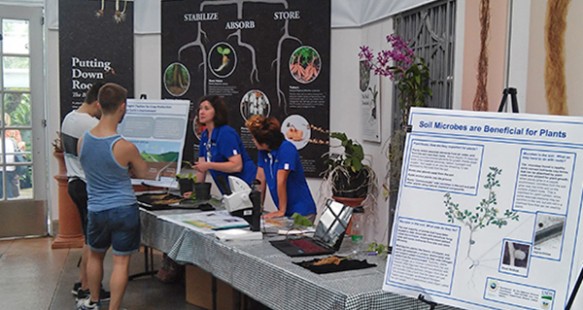
Representatives from the University of Delaware spent a recent Saturday at the United States Botanic Garden in Washington, D.C., educating visitors about the important roles that healthy soils and soil microbes play in ensuring robust plants during a “Roots Festival” held in conjunction with the garden’s exhibit “Exposed: The Secret Life of Roots.”
Janine Sherrier, professor in the Department of Plant and Soil Sciences in UD’s College of Agriculture and Natural Resources (CANR), led the team that included Cherish Warner, a doctoral student in biological sciences in the College of Arts and Sciences who works in Sherrier’s laboratory, and Simone Jimenez, a visiting undergraduate student in the laboratory from Florida International University (FIU) who is taking part in the CANR Summer Institute.
The display and the related research were sponsored by the National Science Foundation, in a research grant awarded to Sherrier and her collaborator, Blake C. Meyers, chair of the Department of Plant and Soil Sciences and the Edward F. and Elizabeth Goodman Rosenberg Professor of Plant and Soil Sciences.
Because the United Nations has dubbed 2015 the International Year of Soils, Sherrier said the timing was perfect to educate the public about the important role soils play in keeping plants healthy and crops productive.
“Since roots are underground, we often forget about what’s happening down there in the dark,” Sherrier said. “When we look at our crops today, we achieve a high level of productivity based on the skills of growers, the genetics of the plants, the equipment and the availability of fertilizer and water, but one component that we haven’t developed fully is the health of the soil. We need to keep our soils healthy if we are going to maintain this level of crop productivity for years to come.”
Sherrier said she was honored that her team was invited to contribute to the “Roots Festival” and that she was impressed by the creative displays and varied plant collections at the U.S. Botanic Garden.
“It’s an amazing, gorgeous garden, and their set up is such that visitors can learn as they explore. It is a lovely walk through their space, and their activities and the level of staff engagement at the festival demonstrated a true commitment to public education,” she said.
At their display, Sherrier, Warner and Jimenez talked to garden visitors about the roles of roots and soil microbes and how they contribute to food production and ecosystem health.
“The whole root system provides so much, not only for the plant but for us agriculturally. The way roots grow determines how they can uptake water, how nutrients are distributed, how other plants will grow around it – it’s really this whole network of interactions,” said Warner.
The visitors were a mix of ages and nationalities, as people from all over the world toured the garden. Sherrier said that participating in the festival was a great way for Warner and Jimenez to gain experience communicating complicated scientific ideas in a way that the general public can understand. They specifically focused on beneficial soil microbes that help plants extract essential nutrients from the environment.
“We had tremendous interactions with the public explaining that healthy soils have a normal complement of microbes, why it is important for plants to interact with soil bacteria, and how these particular microbes could help reduce the environmental impact and carbon footprint of agricultural production,” said Sherrier.
As for the students, Sherrier said that they did a terrific job.
“Cherish was instrumental in designing some of the displays, thinking about how we would present our information. Simone had only been in our laboratory a week at that point, and she’s a natural when it comes to communicating with the public. It was a great opportunity for both of them to be able to communicate our science at a level that the public can understand,” said Sherrier.
Jimenez said that it was “refreshing and enlightening to be visited by people of all ages with such a real interest in soil health and gardening. With Delaware being so agriculture dominant, it was exciting to interact with children and adults and educate them with our root nodules.”
Warner, who also organized the 4-H Marvelous Microbes summer camp with Sherrier and gained experience speaking with youths about science, said, “As a scientist, communicating our research and the reasons it’s important are crucial and vital for us to progress.”
Concerning the highlight of the day, Sherrier said she enjoyed the fact that there were “so many people who were really curious about roots and the environment, and that they genuinely wanted to learn. Having the opportunity to provide that information, to me that was the best part.”
Article by Adam Thomas
Photo courtesy of Cherish Warner